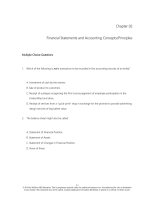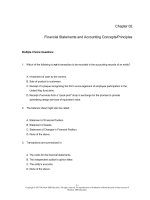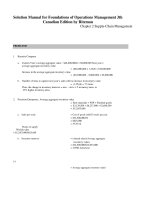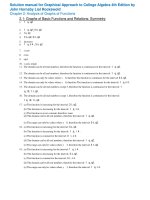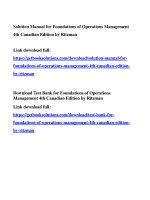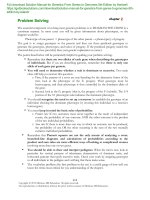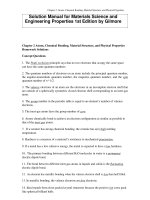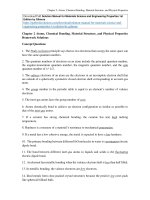Solution manual for accounting what the numbers mean 9th edition by marshall
Bạn đang xem bản rút gọn của tài liệu. Xem và tải ngay bản đầy đủ của tài liệu tại đây (52.72 KB, 4 trang )
Full file at />
CHAPTER
1
Accounting—Present and Past
CHAPTER OUTLINE:
I. What Is Accounting?
A. Definition
B. Uses of Accounting Information
C. Classifications
1. Financial Accounting
2. Managerial Accounting / Cost Accounting
3. Auditing — Public Accounting
4. Internal Auditing
5. Governmental and Not-for-Profit Accounting
6. Income Tax Accounting
II. How Has Accounting Developed?
A. Early History
B. The Accounting Profession in the United States
C. Financial Accounting Standard Setting at the Present Time
1. Financial Accounting Standards Board
2. Standards are Evolving
D. Standards for Other Types of Accounting
1. Managerial Accounting / Cost Accounting
2. Auditing
3. Governmental and Not-for-Profit Accounting
4. Income Tax Accounting
E. International Accounting Standards
F. Ethics and the Accounting Profession
III. The Conceptual Framework.
A. Listing and Context
B. Highlights of Concepts Statement No. 1 — Objectives of Financial Reporting by Business
Enterprises
C. Objectives of Financial Reporting for Nonbusiness Organizations
IV. Plan of the Book.
buy this full document at
Chapter 01 - Accounting—Present and Past
TEACHING/LEARNING OBJECTIVES:
Principal:
1. To present a definition of accounting.
2. To identify and describe different classifications of accounting.
3. To emphasize that financial accounting standards are not a “fixed code of rules,” but are
established in response to user needs and business developments. Accountants need to apply
professional judgment in the application of accounting principles.
4. To emphasize the role and sources of ethics for the accounting profession.
Supporting:
5. To summarize how accounting has evolved over time.
6. To identify sources of standards for other types of accounting and to contrast these with
financial accounting standards.
7. To introduce the issues associated with the development of international accounting
standards.
8. To describe the context of the FASB Conceptual Framework project.
9. To summarize Concepts Statement No. 1 — Objectives of Financial Reporting by Business
Enterprises.
10. To relate the objectives of financial reporting for nonbusiness organizations to those of
business enterprises.
TEACHING OBSERVATIONS/ASSIGNMENT SUGGESTIONS:
1. Students should be put on notice about the jargon of accounting, the use of synonymous
terms, the importance of the context within which a term is used, and the need for precision
in the use of terminology. The first example of jargon is the term entity.
2. When discussing "Auditing — Public Accounting," have students find the auditors' opinion
in the Intel Corporation 2008 Annual Report (see page 112 of the Appendix). Emphasize that
a "clean opinion" is not a "clean bill of health."
3. Discuss the "Highlights of Concepts Statement No. 1 — Objectives of Financial Reporting
by Business Enterprises" in detail. Go over each item in this section with expanded
examples.
1-2
Chapter 01 - Accounting—Present and Past
4. Assign Exercise 1-1. Provide students with the library location and call number of the
reference books identified in part a) or encourage them to experiment with websites that are
of interest. In addition, or as an alternative to having students request their own annual
reports, distribute reports that have been obtained by the instructor.
5. Use Exercise 1-5 to generate discussion about the importance of ethical standards in general
and independence (in both appearance and fact) in particular. Follow up with a brief look at
Exercise 1-7 concerning audit independence standards.
SOLUTIONS:
Matching
1.
2.
3.
4.
5.
A
X
I
D
U
6.
7.
8.
9.
10.
F
B
R
P
Y
Multiple Choice
1. E
2. A
3. B
4. E
5. C
6. A
E1.3.
This exercise provides an opportunity to gauge where the students are in terms of
their prior background in accounting, be it practical or educational, and to clear
up some of the common misconceptions (i.e., explain that accounting goes
beyond the “how to” aspects of bookkeeping and involves the use of judgment).
E1.4.
This exercise provides an opportunity to align student and instructor expectations.
For first time instructors in this course, or for those having a diverse student
group, you will get a glimpse at the common perceptions students have
concerning the course content, level of difficulty, and methods of presentation,
testing/evaluation, and grading.
E1.5.
The principal factors Jennifer Rankine must consider are her competence and
independence. Is she competent to prepare financial statements for a company
that operates in a different industry than the one in which she works? Accepting a
contingent fee arrangement would normally cause an impairment of her
independence because she would directly benefit if the loan were to be approved.
1-3
Chapter 01 - Accounting—Present and Past
E1.6.
Suggested discussion strategy:
Q: Why does a business have value?
A: It provides the owners an opportunity to earn a profit, an opportunity for
personal fulfillment from being in charge, and an opportunity to provide a
product or service that is useful to others.
Q: How can this value be measured?
A: Financial information will have the most to do with evaluating the firm’s
profitability, and the financial statements include this information.
Q: How is an asking price for the sale of a business established?
A: The asking price should be a function of the profit, resources, and obligations
related to the business as shown in the financial statements.
Note: This exercise also provides an opportunity to point out some of the basic
limitations of the data provided by the accounting process (e.g., historical cost
information — how useful are past earnings results in predicting future earnings
and cash flows?). Be careful not to get too carried away with details. Let the
students lead this discussion.
E1.7.
Answers will vary depending on the search engines used by students to locate the
requested information.
E1.8.
Answers will vary depending on the company selected. Note that requirement
d)provides an opportunity to discuss some of the financial statement terms that
are introduced in Chapter 2, for those instructors wishing to get a head start.
1-4
